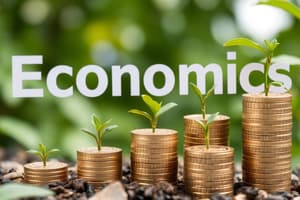Podcast
Questions and Answers
What primary focus does the Classical School of Thought attribute to economics?
What primary focus does the Classical School of Thought attribute to economics?
- The analysis of human behavior
- The study of social welfare and well-being
- The production and distribution of wealth (correct)
- The examination of scarcity and choice
Which school of thought shifted the definition of economics from wealth to welfare?
Which school of thought shifted the definition of economics from wealth to welfare?
- Neo-classical School of Thought (correct)
- Classical School of Thought
- Modern School of Thought
- Behavioral School of Thought
According to Robbins, what does economics primarily study?
According to Robbins, what does economics primarily study?
- The influence of government on markets
- Individual consumer choices in large markets
- Human behavior concerning scarce resources (correct)
- The relationship between wealth and poverty
What is the primary concern of macroeconomics?
What is the primary concern of macroeconomics?
Which of the following accurately describes microeconomics?
Which of the following accurately describes microeconomics?
What criticism is often directed towards the Classical School of Thought's definition of economics?
What criticism is often directed towards the Classical School of Thought's definition of economics?
Which aspect of economics does Neo-classical School of Thought largely ignore according to some economists?
Which aspect of economics does Neo-classical School of Thought largely ignore according to some economists?
What does the term 'micro' specifically imply in economic studies?
What does the term 'micro' specifically imply in economic studies?
What is the primary focus of normative economics?
What is the primary focus of normative economics?
Which statement is an example of positive economics?
Which statement is an example of positive economics?
What is the first stage of capital formation?
What is the first stage of capital formation?
Which factor is essential for the mobilization of savings?
Which factor is essential for the mobilization of savings?
What are capital goods?
What are capital goods?
What is one consequence of a high average level of income regarding savings?
What is one consequence of a high average level of income regarding savings?
Why is investment of savings crucial in capital formation?
Why is investment of savings crucial in capital formation?
What does an economic system primarily aim to allocate?
What does an economic system primarily aim to allocate?
What distinguishes a planned economy from a market economy?
What distinguishes a planned economy from a market economy?
Which of the following is a characteristic of a market economy?
Which of the following is a characteristic of a market economy?
In a mixed economy, what role does the government play?
In a mixed economy, what role does the government play?
How does the government respond when the private sector fails to supply goods?
How does the government respond when the private sector fails to supply goods?
What is the primary goal of price control in a mixed economy?
What is the primary goal of price control in a mixed economy?
What does the absence of government intervention in a market economy typically lead to?
What does the absence of government intervention in a market economy typically lead to?
Which of the following accurately describes resource allocation in a planned economy?
Which of the following accurately describes resource allocation in a planned economy?
What measure may a government take in response to an excess supply of unwanted commodities?
What measure may a government take in response to an excess supply of unwanted commodities?
What is the primary reason interest is prohibited in the Islamic economic system?
What is the primary reason interest is prohibited in the Islamic economic system?
What role does the government play in the Islamic economic system?
What role does the government play in the Islamic economic system?
What does the term 'Zakat' refer to in the Islamic economic context?
What does the term 'Zakat' refer to in the Islamic economic context?
Which of the following best describes the characteristic of 'Mudaraba'?
Which of the following best describes the characteristic of 'Mudaraba'?
What is one of the aims of Islamic economics concerning resource distribution?
What is one of the aims of Islamic economics concerning resource distribution?
What does the term 'HALAL' refer to in the context of the Islamic economic system?
What does the term 'HALAL' refer to in the context of the Islamic economic system?
In the context of monopolies within market economies, what is a potential issue noted in the provided information?
In the context of monopolies within market economies, what is a potential issue noted in the provided information?
What is forbidden in the Islamic economic system concerning wealth management?
What is forbidden in the Islamic economic system concerning wealth management?
What does a point below the Production Possibility Curve (PPC) indicate?
What does a point below the Production Possibility Curve (PPC) indicate?
When moving from point A to point B in the context of a PPC, what is the opportunity cost?
When moving from point A to point B in the context of a PPC, what is the opportunity cost?
What is a characteristic of the Production Possibility Curve (PPC)?
What is a characteristic of the Production Possibility Curve (PPC)?
What could lead to a rightward shift in the Production Possibility Curve (PPC)?
What could lead to a rightward shift in the Production Possibility Curve (PPC)?
Which of the following statements is true regarding the PPC?
Which of the following statements is true regarding the PPC?
What causes a leftward shift in the Production Possibility Curve (PPC)?
What causes a leftward shift in the Production Possibility Curve (PPC)?
How does an increase in capital goods production affect consumer goods?
How does an increase in capital goods production affect consumer goods?
Which of the following is NOT a reason for a rightward shift in the PPC?
Which of the following is NOT a reason for a rightward shift in the PPC?
Flashcards
Adam Smith
Adam Smith
Father of economics, author of "The Wealth of Nations."
Alfred Marshall
Alfred Marshall
Defined economics as the study of mankind's ordinary business.
Lionel Robbins
Lionel Robbins
Economics is the study of human behavior as a relationship between ends and scarce means.
Microeconomics
Microeconomics
Signup and view all the flashcards
Macroeconomics
Macroeconomics
Signup and view all the flashcards
Normative Economics
Normative Economics
Signup and view all the flashcards
Positive Economics
Positive Economics
Signup and view all the flashcards
Capital Formation
Capital Formation
Signup and view all the flashcards
Creation of Savings
Creation of Savings
Signup and view all the flashcards
Mobilization of Savings
Mobilization of Savings
Signup and view all the flashcards
Investment of Savings
Investment of Savings
Signup and view all the flashcards
Planned Economy
Planned Economy
Signup and view all the flashcards
Market Economy
Market Economy
Signup and view all the flashcards
Mixed Economy
Mixed Economy
Signup and view all the flashcards
Distribution of Income
Distribution of Income
Signup and view all the flashcards
Price Control
Price Control
Signup and view all the flashcards
Interest (Islamic)
Interest (Islamic)
Signup and view all the flashcards
Monopoly Control
Monopoly Control
Signup and view all the flashcards
Economic Freedom (Islamic)
Economic Freedom (Islamic)
Signup and view all the flashcards
State Ownership (Islamic)
State Ownership (Islamic)
Signup and view all the flashcards
Moderation (Islamic)
Moderation (Islamic)
Signup and view all the flashcards
Ban on Hoarding Wealth
Ban on Hoarding Wealth
Signup and view all the flashcards
Zakat
Zakat
Signup and view all the flashcards
Mudaraba
Mudaraba
Signup and view all the flashcards
Production Possibility Curve (PPC)
Production Possibility Curve (PPC)
Signup and view all the flashcards
PPC Shape
PPC Shape
Signup and view all the flashcards
Points on PPC
Points on PPC
Signup and view all the flashcards
Points Below PPC
Points Below PPC
Signup and view all the flashcards
Rightward PPC Shift
Rightward PPC Shift
Signup and view all the flashcards
Leftward PPC Shift
Leftward PPC Shift
Signup and view all the flashcards
Study Notes
Economics Definitions: Different Schools of Thought
- Classical School of Thought: Adam Smith is considered the father of economics, authoring "The Wealth of Nations"
- Neo-classical School of Thought: Alfred Marshall defined economics as the study of mankind's ordinary business, focusing on the attainment and use of material well-being
- Modern School of Thought: Lionel Robbins defined it as the study of human behavior as a relationship between given ends and scarce means with alternative uses.
Micro and Macro Economics
- Microeconomics: Focuses on individual decision units like markets, firms, and households
- Macroeconomics: Analyzes the overall performance of the economy
- Normative Economics: Discusses what "ought to be" or "should be" and cannot be proven or disproven
- Positive Economics: Analyzes economic facts and behavior as they are and can be proved or disproved
Capital Formation
- Definition: Net capital accumulation for a country, reflecting additions to the stock of capital goods
- Stages:
- Creation of Savings: Depends on individual's will and power to save, influenced by income levels
- Mobilization of Savings: Transfer of savings from households to businesses for investment, relying on developed financial markets
- Investment of Savings: Deployment of savings into real capital, requiring investment projects and risk-taking businesses
Economic Systems
- Planned Economy: Government makes all decisions about resource allocation, with minimal market input, and sets prices for resources, goods, and services
- Market Economy: Decisions about resources are governed by market forces of supply and demand, with minimal government intervention, and prices are determined by the interaction of producers and consumers
- Mixed Economy: A combination of planned and market economy where both the private sector and the government participate in resource allocation decisions
The Role of the State
- Government's role in a mixed economy includes addressing market inadequacies:
- Distribution of Income: Redistributing income to address inequality through taxation and public spending
- Price Control: Regulating prices of essential goods and services to protect consumers from exploitation by monopolies
- Interest: Islamic systems prohibit interest, promoting profit sharing and partnership models for financing
- Monopoly: Government interventions to counter market distortions by monopolies and wealth concentration
- Economic Freedom: Balancing economic freedom with acceptable economic activity according to Islamic teachings
Islamic Economic System: Features
- State Ownership: Not forbidden but entrepreneurs are free to profit within the system's rules
- Moderation: Emphasizes equitable wealth distribution and sharing
- Prohibition of Interest: Prohibits interest charging, promoting risk-sharing financing practices
- Earnings: Restricted to goods permissible in Islamic teachings
- Ban on Hoarding Wealth: Encourages resource utilization for benefit of society
- Zakat: Financial tax on the wealthy to support the less fortunate
Islamic Finance Models
- Mudaraba: A partnership where the investment company (bank) provides capital and the manager (Mudarib) provides expertise, profits are shared based on agreed terms, and the bank bears any losses.
Production Possibility Curve (PPC)
- Definition: A graph depicting all possible combinations of goods that can be produced from a given set of resources
- Characteristics:
- Downwards sloping and concave to the origin, reflecting increasing opportunity costs
- Points along the PPC represent efficient and attainable production levels
- Points below the PPC are attainable but inefficient
- Points above the PPC are unattainable with current resources
- Shifts in PPC:
- Rightward Shift: Increase in resources (labor, capital, resource quality, technology)
- Leftward Shift: Decrease in resources (e.g., due to war or natural disasters)
Studying That Suits You
Use AI to generate personalized quizzes and flashcards to suit your learning preferences.




